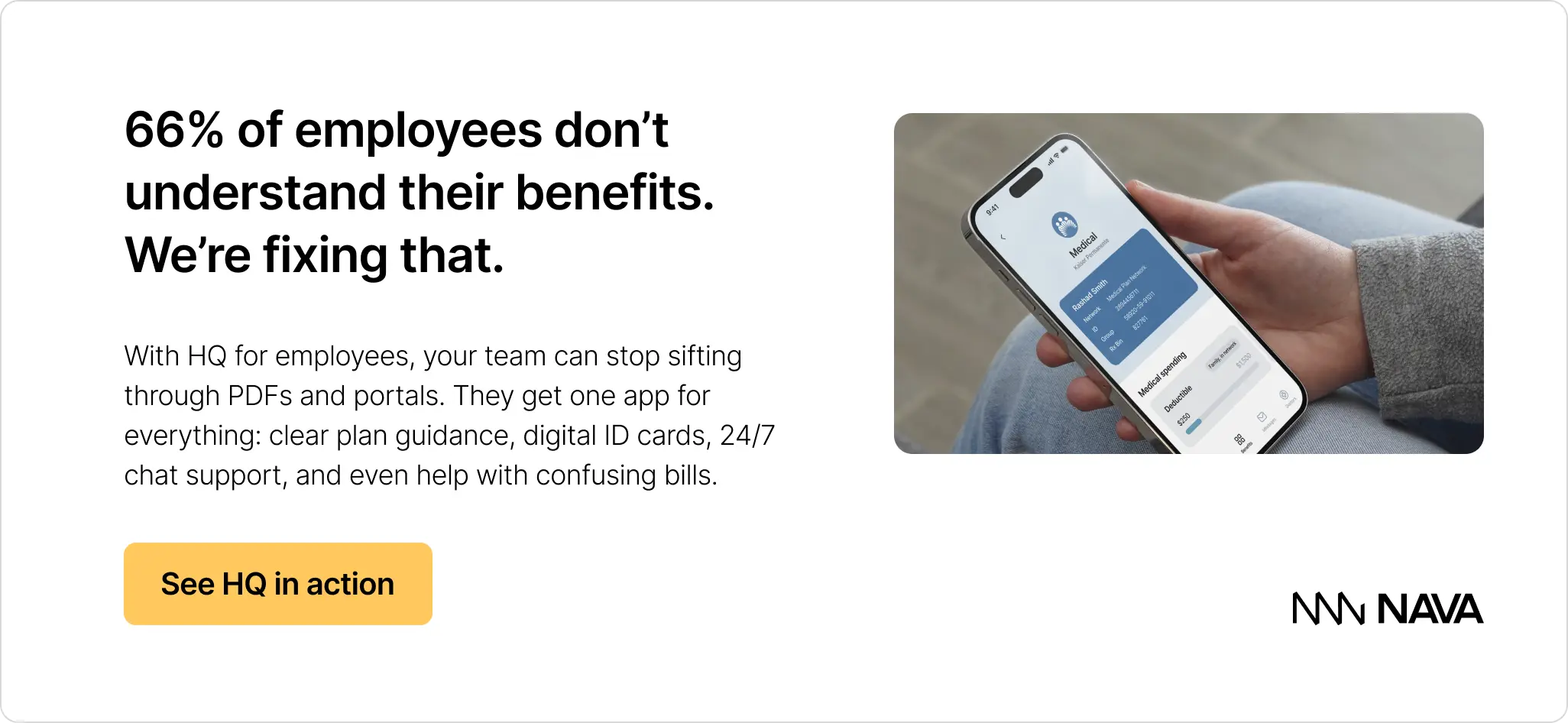Employee health and preventive care: an HR leader’s guide to better outcomes
.webp)
Preventive screenings are one of the most effective tools for improving employee health and reducing long-term costs, yet they’re often underused. This guide explores how HR leaders can make preventive care more accessible through smarter benefits design, clear communication, and year-round education.
Preventive care is one of the most effective tools employers have to improve workforce health, and yet, it’s consistently underused. Many employees skip annual checkups and routine screenings, even though most are covered at no cost under their health plans. For HR leaders, this presents both a challenge and an opportunity: how can you make preventive screenings not just accessible, but expected?
By rethinking plan design, communication, and education, HR teams can play a vital role in helping employees take advantage of the benefits that keep them healthy and catch serious conditions early.
What are preventive screenings?
Preventive screenings are routine medical tests that look for signs of disease before symptoms appear. They’re designed to catch potential health issues early, when they’re easiest and least expensive to treat.
These screenings can identify conditions like cancer, diabetes, heart disease, or high cholesterol long before they cause serious problems. They’re different from diagnostic tests, which are ordered after a person shows symptoms.
When employees take advantage of these screenings, they not only improve their own long-term health outcomes, but they also reduce the likelihood of needing costly, complex treatments down the road.
What’s covered under preventive screenings
Under the Affordable Care Act (ACA), most health plans must cover a broad list of preventive services at no cost to employees, as long as they’re performed by an in-network provider. These include everything from routine physicals and blood pressure checks to cancer screenings and immunizations.
Common examples include:
- Cancer screenings: Mammograms, colonoscopies, cervical cancer screenings, skin exams
- General health: Cholesterol tests, blood pressure checks, diabetes screenings
- Reproductive health: Prenatal visits, contraceptive counseling, STI testing
However, many employees still don’t realize that these services are fully covered or they confuse “screening” (preventive) with “diagnostic” tests (which may involve cost-sharing after an abnormal result). That knowledge gap is one of the biggest barriers HR can help close.
Why preventive screenings matter
The value of preventive screenings goes far beyond compliance.
- For employees: Early detection can mean simpler treatment and better outcomes. For example, when breast cancer is caught at an early stage, the five-year survival rate exceeds 99%.
- For employers: Preventive care reduces long-term healthcare costs and keeps employees healthier, more present, and more productive. In fact, employers who expand access to preventive services (such as via onsite or nearsite clinics) have reported up to 25% reduction in total cost of care, driven by fewer hospitalizations, ER visits, and improved primary care engagement.
- For workplace culture: Promoting preventive care signals that your organization values proactive well-being, not just emergency intervention.
Simply put: When employees take advantage of preventive screenings, everyone benefits.
How HR can make preventive screenings more accessible
Despite the clear advantages, accessibility remains a hurdle. HR can tackle this through thoughtful plan design and benefits education, addressing three main barriers: cost, access, and awareness.
1. Reduce financial and logistical barriers
Even though preventive screenings are typically “zero-cost,” employees may still encounter indirect financial barriers or confusion about what’s covered. HR can:
- Audit plan details with your broker to confirm which screenings are fully covered and whether follow-up visits trigger out-of-pocket costs.
- Partner with vendors that offer at-home testing kits for eligible screenings, such as colon cancer or cholesterol.
- Arrange on-site health fairs or mobile mammogram units to make preventive care more convenient.
- Offer paid time off specifically for medical appointments and preventive care.
- Promote the use of FSAs or HSAs for related expenses, such as transportation or follow-up services.
In some cases, carriers offer incentives for employees who complete preventive screenings or wellness activities, such as gift cards, premium reductions, or contributions to HSAs. These programs vary by plan, carrier, and funding strategy, but they can be a powerful way to boost participation. HR leaders should work with their broker and carrier to understand what incentives are available and how to communicate them effectively to employees.
2. Improve provider access
Access challenges, from limited in-network providers to time constraints, often stop employees from scheduling care. HR can:
- Make it easy for employees to find in-network clinics or labs through your benefits portal.
- Consider telehealth-first plan designs or virtual consultations to discuss screening options.
- For employees in rural or underserved areas, explore health plans with broader networks or regional provider partnerships.
3. Clarify coverage and remove confusion
Clarity is one of HR’s greatest tools, and when it comes to preventive care, even small misunderstandings can keep employees from using the benefits available to them. Many employees don’t realize that preventive screenings are 100% covered when performed by an in-network provider, or they worry they’ll receive a surprise bill if a screening leads to follow-up testing.
HR can help by making these distinctions crystal clear:
- Share simple, side-by-side examples of what counts as a preventive screening versus diagnostic care.
- Use visuals in benefits guides or intranet resources to make this distinction clear.
- Encourage employees to confirm “preventive” billing codes when booking appointments to avoid surprise bills.
- Keep benefits materials up to date as screening guidelines change. For example, the U.S. Preventive Services Task Force recently lowered the recommended age for colon cancer screenings from 50 to 45, expanding eligibility for many employees. Regularly reviewing and updating your communications ensures employees understand which preventive services are available to them at no cost.

Communication strategies: how and when to promote preventive screenings
Even the most comprehensive benefits plan only works if employees know how to use it. Many skip preventive care not out of avoidance, but because they’re unsure what’s covered or when to act. Strategic communication, timed around key benefits moments and delivered in clear, human language, can bridge that gap. When HR teams make preventive care part of regular benefits education, not just a once-a-year reminder, employees are more likely to schedule screenings, stay engaged in their health, and feel supported in doing so.
Make it year-round, not just a campaign
Many people only think about preventive screenings when annual awareness campaigns roll around (like Breast Cancer Awareness Month in October) but these conversations shouldn’t be confined to a single month. Making preventive care a year-round focus helps employees view it as a normal, ongoing part of their health routine rather than a once-a-year reminder.
- Incorporate reminders into open enrollment materials.
- Send seasonal nudges (e.g., “Spring cleaning for your health: schedule your annual screenings”).
- Use milestone-based messaging, such as reminders tied to birthdays or age-based eligibility changes (“Turning 40? It’s time to schedule your first mammogram”).
Normalize the conversation
Many employees delay preventive screenings, even when recommended, and it’s not always because they forget. In fact, 90% of Americans say they’ve delayed screenings, citing barriers like fear, embarrassment, or logistical concerns.
That hesitation often reflects a larger reluctance to bring up personal health topics at work. Here are a few ways you can normalize the conversation:
- Share stories or anonymized testimonials to show the impact of early detection.
- Train managers to support time-off requests for screenings without hesitation or stigma.
- Partner with wellness committees or ERGs to host educational sessions with local providers or advocacy organizations.
Diversify communication channels
Employees absorb information in different ways, some through email or Slack, others through visuals or in-person reminders. To make preventive care messages stick, HR should meet employees where they are. A multichannel approach ensures no one misses important updates and keeps health reminders from blending into background noise. By layering communication across digital and physical touchpoints, HR can make preventive care feel like an ongoing conversation rather than a one-time announcement.
- Combine email, Slack, and benefits newsletters with posters, QR codes, and intranet reminders.
- Leverage your carrier’s existing communication templates to ensure consistency and accuracy.
- Repeat key messages often. Preventive care works best when it’s part of ongoing dialogue.
Technology can also play a big role here. Tools like Nava’s HQ app make it easy to see what preventive care is covered and which providers are in network. Employees can also access 24/7 AI support to ask coverage questions, check costs, and get next steps. Giving employees that level of transparency helps remove confusion and drives engagement with the care that keeps them healthy.
Make information easy to digest and jargon-free
Even the most important health messages lose impact when they’re buried in jargon or dense plan language. Employees shouldn’t have to decode medical terminology or insurance fine print to understand what screenings they need. Keep preventive care communication simple, visual, and action-oriented. Use plain language, short sentences, and clear calls to action like “Schedule your annual checkup” or “Ask your doctor which screenings you’re due for.”
Visual summaries and quick-reference charts can go a long way in making information stick. For example, a simple guide showing which screenings are recommended by age and gender helps employees quickly identify what applies to them.
.webp)
Turn awareness into everyday practice
Encouraging preventive screenings isn’t just about healthcare. It’s about creating a culture where employees feel empowered to prioritize their health.
For HR leaders, that means going beyond open enrollment. It’s about consistent communication, easy access, and benefit designs that remove barriers before they appear.
By normalizing preventive care and making it truly accessible, HR can help employees catch potential issues early, reduce costs, and build a workplace where well-being is more than a buzzword.
.webp)






